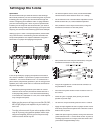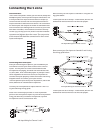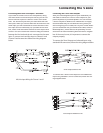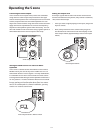
6
Designing an Installation Plan
If you are a professional installer, you’ll probably want to
skip over this section, however if you are setting up your
system for the first time this section can help make your
installation a little bit easier.
Before you start plugging, stripping and connecting wires,
it a good idea to have a clear installation plan. To create
your installation plan you need to consider several design
parameters including what sound sources will be used, if
announcement paging in necessary, which rooms need
to have sound, is remote volume control required, which
type of speakers will do the best job for the room they are
covering, and your wire plan.
Selecting the Sound Sources
The S zone provides four input channels with the ability
to connect up to six input sources. On input Channel’s 1
and 2 there is an input for connecting microphones with
phantom power to operate condenser type mics. You can
connect line level signals on all four input channels, so sig-
nals from TAPE, CD, DVD or Karaoke players, Audio Video
TV monitors, Radio Tuners, DJ mixers or any other line level
device can be used as a sound source. You may also be
able to connect the output from a Home Hi-fi receiver if it’s
equipped with a line level output. For example, in a small
to medium size restaurant you may want background
music from a CD in a room, Disco Karaoke in another room
and have the ability to have a hostess paging parties for
their tables, and a cook paging a waitress to pick up an
order. The S zone can accomplish all of this easily.
Creating the Audio Zones
You can create separate audio environments using the S
zone’s four output channels. Obviously, (or not perhaps
not so obviously,) we call an output a zone on the unit, but
a zone is also the area where you want to have sound. So,
think about where you want to distribute the sound. The
S zone can accomplish all of this easily. In addition, the
S zone let’s you easily connect a remote control level for
each of the zones, so you can control the volume in the
room even if the audio equipment is located somewhere
else.
Now, take some time to consider where you need to
have sound in your particular installation. After you have
decided where you need to create sound zones, you can
consider your speaker selection, but first decide where you
are going to locate your equipment rack.
Locating Your Equipment Rack
Since the S zone is standard19-inch rack mount device,
you should consider using an equipment rack, such as the
Samson SRK8. To select a good location for your equip-
ment rack you should consider several points including
the proximity to each of the sound zones, if the users
need to access the gear like to change CD’s or to adjust a
volume level and if you have a convenient location to the
electrical service, to name a few. You will need to consider
the length of wire runs and routing necessary to make the
connections from the equipment rack to the various sound
zones. Depending on the speakers you choose, and the
length of cable runs you need to make, you may choose
to run speaker level or line level to the sound zones. If you
are using passive (non-powered) speakers you will need to
connect the S zone to a power amp and run speaker wire,
however you need to be careful to pay attention to the
wire gauge and total length of the wire run. If you are us-
ing powered (active) speakers you can run long distances
using the balanced outputs directly from the S zone.
Another type of installation is one that uses speakers
and amplifiers with 70-volt transformers. The benefit of
these systems you can run long lengths of wire and have
many speakers connected to a single amplifier. Since the
equipment used in these types of installations are fairly
specialized, you’ll probably need professional help. Only a
licensed and insured professional sound contractor should
perform installations of 70-volt systems.
Selecting Speakers for Each Zone
To select the speakers you need to consider a few impor-
tant issues like where you are going to place your power
amplifiers, using powered or un-powered speakers, or if
you need to run a 70-volt distributed sound system. The
following sections provide an overview on how to connect
passive speaker or active speakers in a typical installation.
Designing an Installation Plan


















